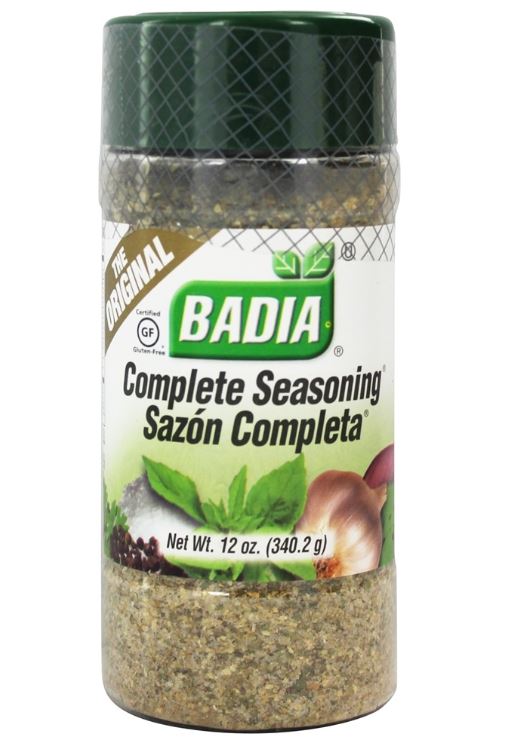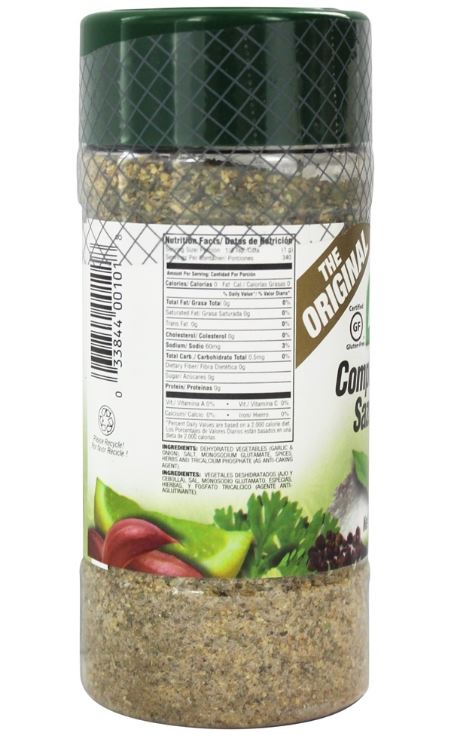Overview
Description
Badia Complete Seasoning 12 oz. (340.2 g)
Badia Complete Seasoning's name says it all: this blend, containing salt, pepper, cumin, and other spices, was inspired by the flavor of Latin cooking and adding it to poultry, fish and meat it will have it ready in seconds for grilling, braising and other preparation methods. It is also a useful ingredient in salads, stews, sauces and vegetables. Complete Seasoning blends well with Allspice, Annato Seed, Bay Leaves, Black Pepper, Chili Powder, Garlic and Oregano. Complete Seasoning is good for poultry, red and white meats, fish and seafood, pickles, relishes, preserves and sauces. Complete Seasoning is traditional in Mexican, Caribbean and Latin American cuisines.
Latin America and the Caribbean countries share many similarities in their diet since it’s greatly influenced by Spain. However, throughout the years and given the various locations, climates and terrain, culinary differences have evolved. Some of the most common ingredients from all the countries in this region are corn, beans and chilies.
- Nicaraguans, Costa Ricans, Hondurans and El Salvadorans often accompany their food with tortillas, which vary in size and thickness according to the country. They are a daily staple, either to have with beans or to accompany with any snack. In some Central American countries, tortillas are filled either with cheese or with pork crackings, as they are in El Salvador.
- The Caribbean islands of Cuba, Puerto Rico and the Dominican Republic were greatly influenced by Spain, and rice is a common food in these three countries - as it is throughout most of the region. One can find "Arroz con Pollo" in the Dominican Republic, "Arroz Con Congri" in Cuba and "Arroz con Habichuelas" in Puerto Rico. These Caribbean countries also add seafood and some local fruits such as papaya and mango to their cuisine.
- Colombia, Ecuador and Peru share similarities in their coastal cuisine, due to the abundance of fish and seafood from the oceans that surround them - the Atlantic Ocean in Colombia, and the Pacific Ocean in Peru and Ecuador. A renowned treat of this region is ceviche, consisting of raw fish marinated in lime juice, salt, chili, onion and garlic. This region is also known for its "sancochos", or soup stews, influenced greatly by the local native Indians.
- Brasil and Argentina have a high appreciation for beef in common. Argentina is known to obtain the best meat cuts. Vacio or Entrana are always accompanied by a chimichurri made with parsley, garlic and oil, for a delicious taste. In Brazil, it's common to eat different kinds of beef, yet in a rodicio, picanha must never be left out.
Mexico's gastronomy includes a variety of delicious cuisine that dates back to 1492, when Christopher Columbus discovered America. The Mexican population incorporated their local agricultural goods to each different meal. The most common staples of the Mexican diet are tortillas and a great variety of chilies, spices and cactuses from the countryside. Whether you eat tacos, fajitas, chimichangas, a hot and steamy pozole, or any kind of sauce, Mexico offers a variety of seasonings to entice all kinds of palates.
- In the Northern Region of Mexico (Sonora, Chihuahua and Zacatecas), Ranchera and Cabrita beef are common and usually accompanied with the peculiar and exclusive chili called Serrano.
- In the Western Region (Michoacan and Jalisco), one can easily find seasoned white fish and delicious Curandas. This region harvests Chilaca chili, which when dried turns to a black color. It is then called Pasilla chili and is consumed in thin slices or over a meal.
- In Central Mexico (Mexico City and Puebla), where you'll find a mix of Spanish and Aztec cuisine, the typical "Mole Poblano" is popular. Mole Poblano is a thick, dark sauce made with dried chilies, nuts, seeds, spices, cocoa and other delicious ingredients that are truly appreciated.
- Veracruz, on the Gulf Coast, offers excellent seafood, as well as good Atole. Jalapeno chili is the most common in the region, and its name refers to the many years it was harvested in Jalapa, Veracruz.
- On the Yucatan Peninsula, one can become fascinated by the Cochinita Pibil. The Yucatan peninsula's classic chili is the Habanero chili, which is known to be the hottest of all, and is eaten fresh, raw, broiled and cooked.
Jose Badia left Spain in 1960, looking for new opportunities in the New World. He first landed in Santiago de las Vegas, Cuba, where he became known for his hardware store, Badia & Garrigo. In 1963, with difficulties facing Cuba, Jose emigrated to Puerto Rico and entered the world of spices. After leaving Puerto Rico in 1967, the Badia family looked for new markets in Miami, the land of Cuban immigrants, building brand loyalty. There, Badia begins to grow with the help of another company, and begins to appear on grocery store shelves. Slowly, Badia becomes more popular and well-known, and it spreads to more grocery stores. By 1998, Badia has expanded worldwide. More than 350 UPC’s, placement in 1100 points of sale in the U.S., international markets in three continents, international distribution and a dynamic, high-tech production line with an increase of 28,000 square feet at its new warehouse prove Badia is a great leader in its category.
Badia strives to be the strongest ethnic line of spices in the marketplace, with the most competitive prices and an exceptional selection of products for consumers to choose from.
Suggested Use
Use it on all kinds of meats, poultry and fish, and sprinkle it on soups, salads, sauces and vegetables.
Ingredients
| Badia Complete Seasoning 12 oz. | |||||||||||||||||||||||||||||||||||||||||||||||||||||||||||||||||||||||||||||||||||||||||||||||||||||||||||||||
|
|||||||||||||||||||||||||||||||||||||||||||||||||||||||||||||||||||||||||||||||||||||||||||||||||||||||||||||||
| Other Ingredients: Dehydrated vegetables (garlic & onion), salt, monosodium glutamate, spices, herbs and tricalcium phosphate (as anti-caking agent. | |||||||||||||||||||||||||||||||||||||||||||||||||||||||||||||||||||||||||||||||||||||||||||||||||||||||||||||||
Questions & Answers
2 Reviews
Needless to say, after a week or so I quit using. They need to be smoother and actually have the ability to dissolve.



















It works!
Recommended by a friend
trying a new brand of zinc lozenge
Good for colds etc..